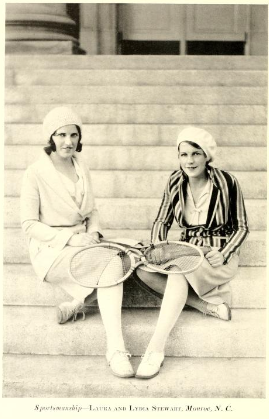As the college moved into the 1930s, it underwent transformations that reflected the unsettled economic trials of the country. The stock market crash of 1929 threw the nation into a financial crisis, resulting in a drop in enrollment and faculty pay for the North Carolina women’s college. Faculty took an additional hit when Greensboro banks failed in 1933. In the midst of these calamities, and under the watchful eye of President Julius Foust, the school officially consolidated with the University of North Carolina and the North Carolina College of Agriculture and Engineering, and was renamed the Woman’s College of the University of North Carolina.
Yet during these tumultuous times, the Pine Needles yearbook maintained its high quality with a combination of photographs and interesting graphics. Most of the yearbooks from the 1930s had themes which gave the publications a visual focus. The 1932 edition featured the “melting pot” of American culture with chapter illustrations that represented various groups of North Carolina settlers. The theme of the 1933 yearbook was mysteries and superstitions, incorporating drawings of stylishly dressed young “detectives” who resembled the recently created heroine, Nancy Drew. This edition also reflected an unusual part of the college’s history when men were briefly admitted as day students during the Great Depression. It was during this time that Pine Needles began to consistently include photographs of the faculty and students; campus buildings; “superlatives;” class mascots; and societies, organizations, and clubs. Dedication and In Memoriam pages saw older faculty members and students remembered by the campus community.
The 1941 Pine Needles ushered color into the annual publication and featured the 50th anniversary of the founding of the college. This yearbook, as well as the 1942 – 1946 volumes, covered the years when World War II was a major part of the daily life of the school and the country. Through the War Service League, the students and faculty, led by Chancellor Walter Clinton Jackson, contributed a great deal to the war effort. Yet, beyond the war, 1940s yearbooks also reflected the growth of the college, with events such as the Arts Forum and Social Science Forum and the founding of the Weatherspoon Art Gallery. At the end of the decade, the school was the largest women’s college in the United States and Pine Needles attempted to modernize its design by replacing quaint themes with a look to the future.
The 1950s brought a great deal of change to the campus. Chancellor Jackson retired in 1950 and many older campus buildings were replaced by more functional structures. The decade also saw the desegregation of the campus in 1956 with the admittance of JoAnne Smart and Bettye Ann Davis Tillman. Although JoAnne and Bettye were included in individual and dormitory group photographs, it would take years before African American students were truly represented in Pine Needles. As the college moved into the 1960s, enrollment was at an all-time high, but Woman’s College was facing many challenges which reflected larger national issues, such as Civil Rights and the Vietnam War. Part III of the History of the College’s Yearbook will cover the school’s move to co-education, campus activism, and the demise of Pine Needles.
By Kathelene McCarty Smith
